
Tour course
Day 1: Ulaanbaatar – Tsagaan Suvarga
Day 2: Tsagaan Suvarga – Bayanzag
Day 3: Bayanzag – Khongoryn Els (camel trekking, sand boarding experience)
Day 4: Khongoryn Els – Yoliin Am (horseback riding experience)
Day 5 : Yoliin Am – Baga Gazriin Chuluu
Day 6: Baga Gazriin Chuluu-Ulaanbaatar
The accommodation is a traditional Mongolian ger tourist camp where travelers can rest comfortably. Ger accommodations are allocated according to the number of people in rooms of 2 to 6 people. Depending on the situation, traveler can stay alone.
* Showers are available for the entire trip at camps.
* Electricity is available for the entire itinerary
* Tour can be carried out with a minimum of 2 people. Or please discuss with our manager if you want solo travel.
* For our tours, we drive in SUV, Starex or Furgon travelling car.
* Breakfast and Dinner will be served at a tourist camp and lunch will be served at a local restaurant. Foods include traditional nomad food such as horhog (Mongolian barbecue), tsuivan (Mongolian spaghetti), and others traditional culinary.
* Includes 1 airport drop-off and 1 pickup / Additional pickups incur additional charges
Day 1: Ulaanbaatar - Tsagaan Suvarga
Takes 7 hours
Our driver and guide will pick up you from your designated hotel or from airport and you will start your tour towards Tsagaan Suvarga. (When starting the tour from the airport: The tour starts according to the traveler's flight arrival schedule)
Most of the roads in Mongolia's Gobi are unpaved off-road roads. Bringing a personal neck pillow will help you move more comfortably. After unpacking at the ger camp located on the vast land, we head up to Tsagaan Suvarga to watch the sunset. For those who want to experience the spectacular scenery of this place closer, we recommend trekking on foot.
Tsagaan Suvarga, situated in the Gobi Desert, is a distinctive location with a history rooted in its past life as an ocean bed. Visitors exploring this site encounter marine fossils and clamshells amid the vibrant landscape of a 30m-60m high and 6000m long limestone formation. Accessible through a 420 km paved road and an additional 30 km on an unpaved road from Ulaanbaatar, travelers often take a break at the center of Dundgovi province before embarking on a 156 km journey to reach the Tsagaan Suvarga scenic spot.
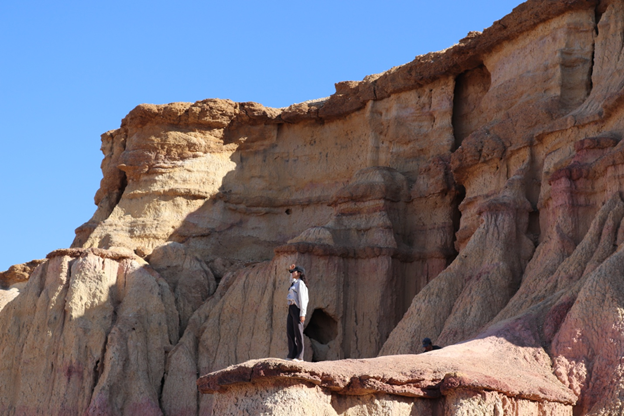 |
 |
While walking ton Tsagaan Suvarga, enjoy the 360-degree panoramic view of the Gobi. This is a place where you can cherish beautiful sunrises and sunsets. Then we move to your accommodation and enjoy relaxing evening while having traditional Mongolian cuisine for dinner. After sunset, throughout the night, the Gobi sky will give you its wonders of The Milky Way stars, outdoor pork belly, and cool bare liquor are on this day. ^^
Takes 4 hours
After breakfast, we leave to Bayanzag, famous as the Flaming Cliffs.
Breakfast/lunch/dinner available
Bayanzag is called the Grand Canyon or Flaming Cliffs of Mongolia. We reach the Bayanzag red sand cliffs, where the renowned American paleontologist Roy Chapman Andrews led the pioneering expedition in the 1920s, making the first-ever discoveries of dinosaur bones and eggs. Now recognized as the "flaming cliffs" for their vibrant ochre and red hues, Bayanzag's exploration brought global focus to the Mongolian Gobi. Additionally, archaeological findings in Bayanzag include stone tools from ancient human habitation sites, exhibiting structures similar to those discovered in the American Alaska Peninsula.
Bayanzag dinosaur fossils findings include Velociraptor, Oviraptor, Protoceratops and Pinacosaurus fossils. We recommend you to experience the feeling of an Indiana Jones adventure in this endless desolate place.
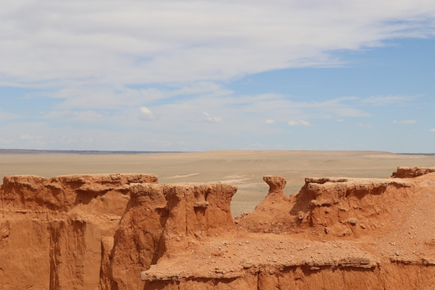 |
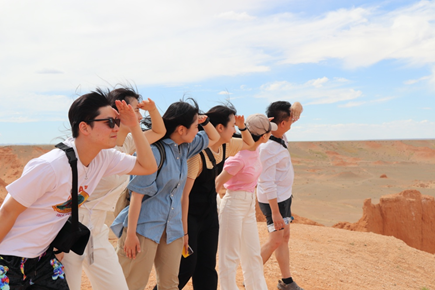 |
Takes 3 hours
After breakfast, we will head to the Khongoryn Els Sand dunes.
You can see one of the seven major deserts of Mongolia and the highest sand dune in the enormous desert, which is 300m high and 100km long. Here you can ride a Bactrian camel for an hour and enjoy a sandboarding experience on the sand dunes. And you will eat horhok, a truly delicious representative dish of Mongolia. Bactrian camel trekking experience (duration: approximately 1 hour) Experience a unique experience and take memorable photos at various points. After dinner, while observing the starry night sky, you will spend relaxing evening.
 |
 |
Takes 1 hour
About Bactrian camel: scientific name: (Camelus bactrianus) or Bactrian camel is a branch of camel that inhabits the grasslands of Northeast Asia. As the name suggests, Bactrian camels have two humps, unlike dromedary camels. It is stronger than a dromedary camel and its limbs are thick and short. There are two humps on the six peaks, and the fur is long and thick. The soles of the feet are hard and are suitable for hilly areas with a lot of rocks or gravel. They have been bred in Mongolia, the Gobi Desert, and China since ancient times, and some are found in a semi-wild state. The cubs' eyes are open from birth, and their bodies are covered with wool-like fur. They can run a few hours after birth, and cubs and their mothers stay together for years unless they are separated.
★Short caution: When riding a camel, it is best to refrain from wearing brightly colored clothes or clothes that make a lot of noise in the wind, and do not wear shoes with rough soles. When approaching a camel, speak calmly. You must approach from the left or front side.
★If you do not want a camel experience, you can freely travel outdoors.
★Camel experience safety education provided (You must receive explanations from an expert for about 10 minutes before the camel riding experience.)
Duration: 1 hour
Takes 1 hour
You can enjoy a sandboarding experience on huge sand dunes.
Takes 1 hour
Horhog is a traditional Mongolian dish. It is a food eaten on holidays or when there is an auspicious occasion at home, or served to important guests. Put a hot stone in an iron container filled with water, place lamb cut into bite-sized pieces and heated stones alternately on top, add vegetables such as onions and salt, close the lid, seal it to prevent steam from escaping, and steam it on the stove for about two hours.
The smell of lamb that feels like it's been grilled but also smoked! Thanks to the time and effort put into it, the taste of Horhog cuisine is truly the best of Mongolian food.
Takes 4 hours
After breakfast, we will travel to Dalanzadgad, Dalanzadgad, a town city of the Umnugovi province (South Gobi province), via Yoliin Am, the biggest attraction in Govi Gurvansaikhan National Park.
Have lunch in Dalanzadgad and take a quick tour of the city. Later we head to Yoliin Am. The biggest attraction of Gurvansaikhan National Park, surrounded by a desert and a canyon of strangely shaped rocks, is a famous tourist destination with many wild animals, including eagles, living up to its name, Eagle Valley. In Yoliin am, you can experience riding a horse through the canyon.
It is a unique place to experience different and take scenic photos.
 |
 |

Optional activity: Horseback trekking in Yoliin Am (duration: approximately 1 hour)
After the trekking, we drive to the accommodation for dinner and rest.
Optional activity: Horseback riding experience is an optional.
If you do not want to go horseback riding, you can relax at the accommodation or take a walk.
Horseback riding safety education provided (You must receive explanations from an expert for about 10 minutes before horseback riding.)
★Horseback riding short caution: 1. You must never stand behind a horse. 2. When riding a horse, get on and off on the right side. 3. When you want to run a little faster or run... you say choo choo.
After the trekking, move to the accommodation for dinner and rest.
Takes 6 hours
After breakfast, we drive to Baga Gazriin Chuluu. The impressive granite formations known as Baga Gazariin Chuluu (The stones in small ground), meaning "stone of the little place," are situated in the northwestern part of Dundgovi province, nestled in the heart of the steppe. Located 250 km (155.34 miles) south of Ulaanbaatar in the Delgertsogt district, these formations, standing at an elevation of 1751 meters (1.09 miles), create a granite canyon amid the expansive steppe landscape. Erosion has intricately polished the rock faces of the cliffs, and while some lateral entries into the canyon may be challenging to access, many of them offer opportunities for captivating hikes through this rocky labyrinth. On the rock faces, one can observe inscriptions left by revered monks who resided there during the 19th century.
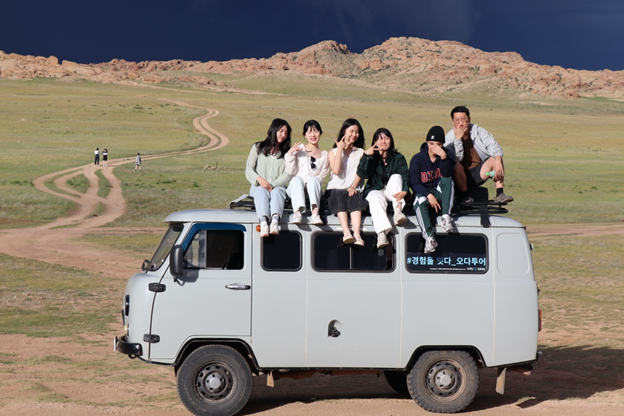 |
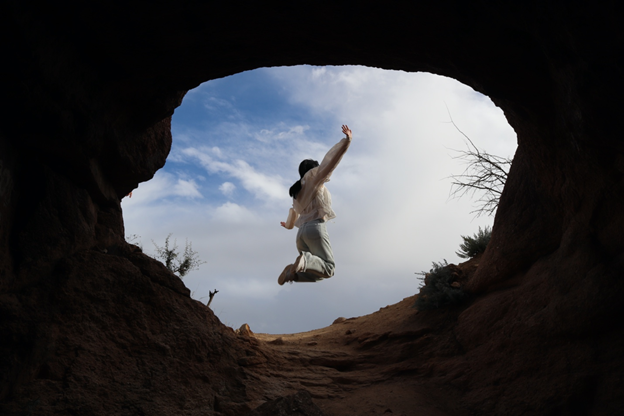 |
Takes 3 hours
Baga Gazariin chuluu - Ulaanbaatar city
5 hours / 250 km
After breakfast, we drive to Ulaanbaatar city. In this day, depending on your departure schedule, we offer you
▶ City tour
▶ Shopping at state-run department store Keshmere Outlet
▶ Airport drop-off
Ulaanbaatar city is the capital of Mongolia. The city's name means 'red hero' in Mongolian. The area is 4,704.4km² and the population is 1,673,000 (2023). The first recorded capital city of Mongols was created in 1639 at Lake Shireet Tsagaan nuur as a nomadic Buddhist monastic centre. Urguu as yurt monastery was intended by the Mongol nobles to be the settling place of Undur Gegeen Zanabazar, the first Jebtsundamba Khutugtu. Changing location 28 times between 1639 to 1778, as the city grew, it moved less and less. Urguu was permanently settled at its modern location in 1778 near the confluence of the Selbe and Tuul rivers and beneath Bogd Khan Uul.
Name changes: The city at its establishment in 1639 was referred to as Örgöö. By 1651, it began to be referred to as Nomiĭn ('Khüree of Wisdom'), and by 1706 it was referred to as Ikh Khüree ('Great Khüree'). Other names include Bogdiin Khuree, or simply Khüree ( Khüree), itself a term originally referring to a settlement.

Upon independence in 1911, the city's name was changed to Niislel Khuree (Capital Khuree). In 1924, its name was changed to Ulaanbaatar ( 'Red Hero').
Takes 1 hour
In July 1921, in Ulaanbaatar (the city name of Ulaanbaatar was changed after Sukhbaatar's death), Damdin Sukhbaatar declared independence from China (the fall of the Qing Dynasty in 1911). Damding Sukhbaatar was a soldier who worked hard for Mongolia's independence by helping the Mongolian leader at the time, Bogd Khan, and organized the People's Revolutionary Party, which led to the formation of the People's Party, one of the political parties in the current Mongolian National Assembly. Later, in 1923, at the young age of 30, Sukhbaatar suddenly died of illness. On the 25th anniversary of the Socialist Revolution in 1946, a square was built to commemorate him and his statue was erected in the center.
In the northern side of the square, Chinggis Khaan’s large statue is centered. The statue to the west is his son, the 2nd Khan Ogedei Khaan, and the statue to the east is his grandson, Kublai Khaan, the 5th Khan and the first emperor of the Yuan Dynasty. The statues were built to commemorate the 800th anniversary of the founding of the Mongol Empire. And the two equestrian statues in front of Genghis Khan are the Mongolian warriors Boorchu and Mukhlai.